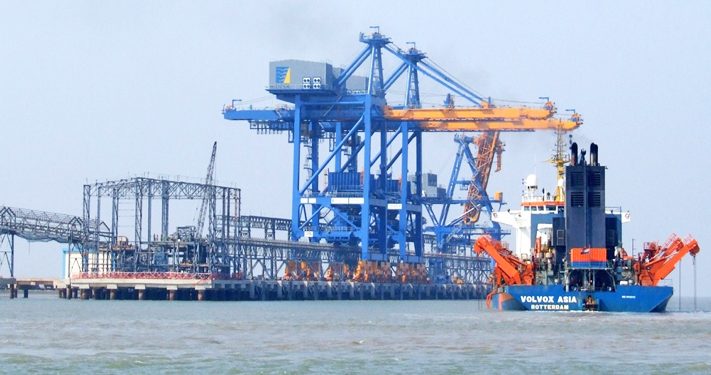Dhamra(Odisha): Adani Group and French company TotalEnergies’ newly built Rs 6,000 crore LNG import facility at Dhamra on the Odisha coast has received its first-ever shipment of liquefied natural gas – a fuel that will be used to make steel, produce fertilizers and turned into CNG and cooking gas, helping change the landscape of Eastern India.
Qatari ship ‘Milaha Ras Laffan’ docked at Dhamra Port April 1 morning, bringing in 2.6 trillion British thermal units of natural gas in its frozen form (LNG) which will be used to commission the facility, officials said.
Commissioning and testing operations will take up to 45 days and commercial operations are expected to start thereafter. The start of the 5 million tonne per annum LNG import terminal is crucial to Prime Minister Narendra Modi’s plan to boost natural gas use in the country’s energy mix to 15 per cent by 2030 from current 6.3 per cent.
Dhamra is the only LNG import terminal in eastern India and only second on the entire east coast. The country’s five other terminals are on its western coast (three in Gujarat, one each in Maharashtra and Kerala).
Adani Total Pvt Ltd, where Adani Group and TotalEnergies SE have 50 per cent stake each, will use the cargo received April 1 to do safety check and test systems, officials said.
After all checks, the terminal would be ready to start commercial operations with an expected 2.2-2.3 million tonne of LNG expected to be imported in the first year and a gradual ramp-up to full capacity in the next.
The 135,000 cubic meter capacity Milaha Ras Laffan was loaded at Qatargas March 21. The test cargo has been provided by TotalEnergies from its portfolio.
Dhamra is a tolling facility where state-owned GAIL (India) Ltd and Indian Oil Corporation (IOC) have booked capacity. They will import LNG at the terminal which will be re-converted into gas before being piped to refineries and fertiliser units. It will also be converted into CNG for running automobiles and piped into household kitchens for cooking purposes.
It has a 20-year take-or-pay contract to provide regasification services to IOC for 3 million tonne per annum of LNG and 1.5 million tonne to GAIL.
Officials said the commissioning cargo was received on Utkal Divas – the day in 1936 when the state of Odisha (earlier Orissa) was formed.
This marks commencement of the terminal’s commissioning, with a number of stages to be completed in the coming weeks.
The terminal will be able to berth the widest range of LNG vessels all year round, transport gas via pipelines, trucks or on reloaded vessels. It houses two storage tanks, each of 180,000 cubic meters capacity, amongst the largest in the country.
The capacity can be doubled to 10 million tonne in future by adding a third tank, they said.
Adani Total is a partnership of complementary skillsets. While Adani has world-class infrastructure and port development capabilities, TotalEnergies is the 3rd largest global LNG player globally.
Together, the JV built and delivered the project over the past four years, overcoming several challenges like the pandemic, cyclones, difficult soil conditions, supply chain disruptions and the highly volatile LNG market due to the conflict in Europe.
Officials said Dhamra will be the main supply point on the recently completed Urja Ganga pipeline developed by GAIL, providing gas access to over 35 per cent of India’s population, covering about 20 per cent of the country’s land mass.
Refineries, fertiliser plants, industries and city gas networks in the hinterland will be the major consumers of gas from Dhamra LNG.
The Urja Ganga pipeline is also connected to the other National Gas Grid – the Hazira-Vijaipur-Jagdishpur (HVJ) pipeline, providing customers in the north of the country with a ready alternative source of supply when compared to the western terminals on whom they are solely dependent at present.
Its proximity to Bangladesh and other regional markets allows Dhamra to become a viable point of supply to them as well, they said adding the Srikakulam-Angul and Mumbai-Jharsuguda pipeline projects will soon connect Dhamra to central and southern states, completing the National Gas Grid integration.
The long-term price of LNG trades at a discount of more than $5 per million British thermal unit compared to alternative liquid fuels like naphtha, fuel oil and diesel.
The current annual consumption of substitutable liquid fuels across refineries, fertiliser plants and industries in the eastern region is of the order of 5 million tonne per annum.
Based on this, substituting 5 million tonne equivalent liquid fuels with LNG would represent a saving of USD 1.25 billion (about Rs 10,000 crore) per annum for the Indian economy, they said.
LNG is predominantly methane (C1) gas chilled to around minus 160 degrees Celsius where it turns into a liquid at atmospheric pressure, occupying less than 1/600th of the volume it otherwise would. This allows huge quantities of energy to be transported across oceans in specialised vessels.
It is considered as a bridge fuel for India’s energy transition. Last year, the global LNG trade reached around 400 million tonne. Over the past three years, Indian imports have varied between 22 and 24 million tonne representing around 3 per cent of the country’s primary energy basket.
PTI






































